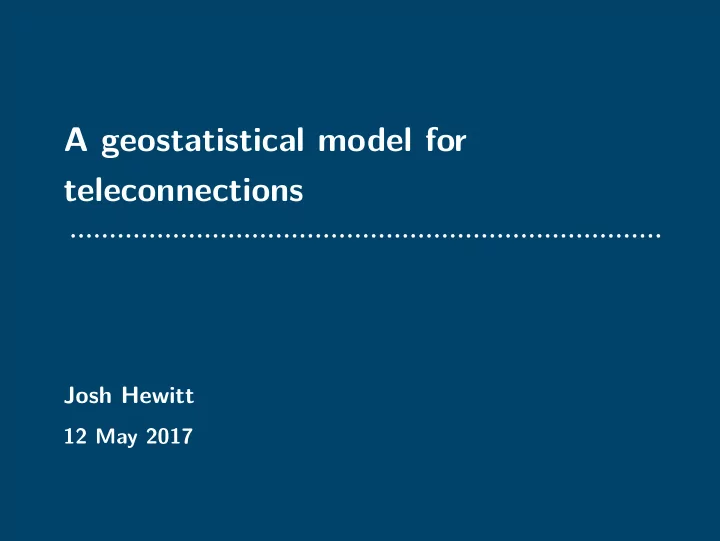

A geostatistical model for teleconnections Josh Hewitt 12 May 2017
Joint work with • Jennifer A. Hoeting • James Done • Erin Towler 1
Motivation • Estimate teleconnections and test for significance while – accounting for spatial dependence – accounting for impact of local factors 2
Contributions Climate science • Alternative to compositing by directly controlling for local covariates • Alternative to post-hoc multiple testing corrections by directly accounting for spatial dependence Spatial statistics • Methodology for spatial modeling with remote effects 3
Case study: Colorado precipitation • (Reanalysis) Data (33 winters: 1981–2013) – Y ( s , t ): PRISM precipitation – x ( s , t ): ERA-Interim covariates • Local covariates: TCWV , T , Z 700 , Elevation • Local domain: 240 42km-resolution grid cells • Remote domain: 5,252 78km-resolution grid cells 4
Remote effects spatial process (RESP) model ∫︂ = x ( s , t ) T β + + Y ( s , t ) w ( s , t ) + ε ( s , t ) z ( r , t ) α ( s , r ) d r ⏟ ⏞ ⏟ ⏞ ⏟ ⏞ D Z Std. Precip. anomaly Local effects Spatial + Independent error ⏟ ⏞ Teleconnection effects 5
Remote effects spatial process (RESP) model • Reduced rank approximation – Aggregate ocean data for more stable results – Aggregation parameters statistically optimized/estimated )︄ [︄ )︄ [︄ – α ( s , r ) = √︂ k j =1 h r , r ∗ α s , r ∗ j j 6
Remote effects spatial process (RESP) model • Remote effects parameterization: Spatial basis fns. – Estimate teleconnections for EOFs or other patterns – z ( r , t ) = √︂ K k =1 a k ( t ) ψ k ( r ) 7
Bayesian hierarchical implementation ⋃︁ ⋂︁ Y ( s 1 , t ) . ⋀︁ ∼ N )︄ X t β + )︄ [︄ α , Σ [︄ ⋁︁ ∑︂ I n s ⊗ z T . Y t = ˜ . ⨄︁ t Y ( s n s , t ) α ∼ N ( 0 , Σ ⊗ R ) ˜ β ∼ N ( 0 , Λ) σ 2 ∼ Inv-Gamma ( k , θ ) ρ ∼ Uniform ( a , b ) X t : Matrix of all local covariates for time t α : Vector of teleconnection effects for all locations ˜ Σ : Covariance matrix for Colorado locations R : Covariance matrix for teleconnection effects α ( · ) θ = )︄ σ 2 , ρ [︄ : Covariance matrix scale and range parameters (Λ , k , θ, a , b ) : Hyperparameters 8
Case study: Parameter estimates • Estimates account for remote covariates Posterior mean 95% HPD VIF 0 (-0.058, 0.059) 1 β 0 β TCWV 0.491 (0.424, 0.554) 1.2 (-0.362, -0.241) 1.1 β T -0.302 β Z 700 -0.149 (-0.224, -0.078) 1.2 β ELEV 0 (-0.049, 0.046) 1 σ 2 0.322 (0.303, 0.341) w σ 2 0.004 (0.003, 0.005) α σ 2 ˜ 0.093 (0.086, 0.099) ε ρ w 37.11 (35.766, 38.332) 6.657 (1.306, 11.166) ρ α 9
Case study: Teleconnection estimates • RE model uses spatial dependence to “interpolate” significance in correlation maps • RESP model suggests positive (red) teleconnection effects are fully expressed through local covariates 10
Case study: Data fit 11
Case study: Model comparison ⎞ ˆ )︂ • Fit measured with Heidke skill: HS ∝ P Y ( s , t ) = Y ( s , t ) 12
Conclusions and future work • Conclusions – A new class of spatial statistics problems in which distant locations are correlated. – Geostatistical model that incorporates both local and spatially remote covariates modeled via different spatial processes. – A more formal framework than previously available for studying teleconnection patterns while accounting for local covariates and spatial dependence. • Possible future work – GLM version of model to study teleconnection impacts on annual number of rain events. – Extension to allow temporal variation to account for changing teleconnections. 13
Acknowledgements • Conference and workshop travel under NSF research network on STATMOS through grant DMS-1106862. • This material is based upon work supported by the National Science Foundation under Grant Number (NSF AGS - 1419558). Any opinions, findings, and conclusions or recommendations expressed in this material are those of the author(s) and do not necessarily reflect the views of the National Science Foundation. 14
Recommend
More recommend